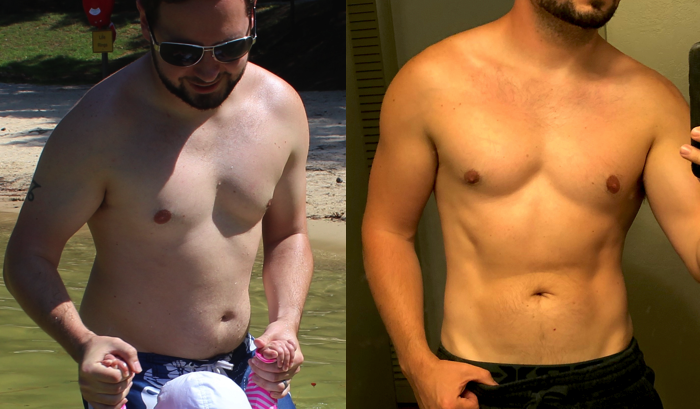Want a chiseled set of abs?
You’ll need to do exactly 267 sit ups.
Aaaaaand, go!
…
OK, I’m kidding. Obviously.
You’re here for the truth about how to get a flat stomach and six pack abs, and the truth is that no amount of sit ups is going to do the trick.
Not 30 per day. Not 50 per day. Not 100 sit ups per day. Not 5 million over the next year.
Sit ups are a fine ab exercise (though I’ll argue below there are many way, way better ones), but truthfully ab exercises have very little to do with getting a flat stomach.
So the question, ‘how many sit ups to get a flat stomach’ is kind of missing the point.
Getting that washboard belly is actually pretty simple (but not easy), and sit ups can certainly be a part of the equation, but they can’t do the job on their own.
Below you’ll find out:
- The three step formula for toned abs
- How to diet for abs and a six pack
- Why you need full body strength training for a flat stomach
- Which kinds of direct ab exercises work best
- What to expect along the way
- Why cardio is optional (and why too much will hurt you)
Let’s go!
The three step formula for a flat stomach & toned abs
As I wrote above, getting a flat stomach is actually pretty simple.
Meaning, the process is simple. It’s only a few steps long.
That doesn’t mean actually doing the work will be easy. How do I know? I’ve done it!
(Granted I don’t have a chiseled six pack quite yet, but I’ve lost a ton of fat and built strength following an incredibly effective full nutrition and workout program.)

But if you decide you really want to do this, and you want to really commit over the long haul (this will take some time unless you’re already pretty skinny), here’s the basic blueprint for abs, or even just a flatter tummy:
- Step one: Lose fat
- Step two: Full body strength training
- Step three: Direct ab work
Step One: Lose (probably lots) of body fat
The biggest reason your stomach isn’t flat, and/or why you can’t see your abs, probably has very little to do with your core strength.
If you’re like most people (and me, not too long ago) you just simply have too much fat around your midsection.
If all you want is a flatter stomach, the answer is simple: Lose a lot of fat.
(Shredded abs will take a little longer, and more work)
There are tons and tons of ways to do this (intermittent fasting, ketogenic diet, paleo, low carb, Atkins, calories in calories out), but take it from me: You’re going to see 90% of your results from your total calorie intake and expenditure.
To lose weight, you need to eat less energy than you burn, basically.
Eating clean, getting lots of fruits and vegetables, and avoiding overly processed food is great. But if you can maintain a consistent calorie deficit over time, your body will have no choice but to chew into its fat reserves and burn them off.
The simplest way to get started is this: Multiply your bodyweight x 12 for your daily calorie goal.
If you’re 150 pounds, that means you’ll eat about 1800 calories for consistent and safe weight loss.
If you want to be aggressive, you can use goal bodyweight x 12 for a bigger calorie deficit.
Stick to that and the weight will come off.
(***It’s also important to note here that you can’t ‘spot reduce’ fat. Your body will burn through fat according to its own preferences across your entire body, and no amount of crunches or sit ups will force you to burn belly fat.)
Step Two: Build full body strength
When you’re losing a lot of weight, you’ll probably want to avoid your body eating into its muscle mass for energy.
Trust me, you’ll look your best if you maintain overall muscle and strength while losing mostly fat.
(Ever see an Olympic marathoner? They’re in tremendous shape and have very low levels of body fat, but, at least to me, they don’t look all that great because they have very little muscle mass. It’s probably not the look you’re going for.)
For a great looking stomach, full body strength training while dieting is an absolute must.
Focus on heavy, compound lifts that help build core (and ab) strength, like:
- bench press (chest, triceps & core)
- incline press (chest, shoulders, triceps & core)
- overhead press (shoulders, triceps & core)
- squats (legs, back & core)
- deadlifts (legs, back & core)
- rows (back, biceps & core)
- pull-ups (back, biceps & core)
Along with a little isolation work on smaller muscles like biceps, triceps, shoulders, calves, etc.
(If you don’t like the gym, you can do most of this at home with dumbbells, or even bodyweight movements like squats, push ups, and pull ups.)
If you’re new to lifting weights, you’ll probably be able to build quite a bit of strength and new athleticism even while dieting. But regardless, strength training while you eat in a calorie deficit will force your body to hold on to more muscle mass than pure dieting alone would.
You’ll lose more fat faster this way and start to tighten up that midsection.
(It seems counterintuitive to work your arms and shoulders for a flatter stomach, but trust me, it’s a crucial part of the process.)
Step Three: Do direct, high impact ab work

Hey, it’s finally time for sit ups to make their grand entrance!
Only… maybe not.
If a well-defined stomach is your goal, some direct work on your abs will definitely help.
But forty thousand sit ups probably isn’t the answer.
If you’re doing all of the above (losing weight and maintaining/building strength) you are WELL on your way to a flat stomach. Keep it up! In fact, direct ab work might be totally optional for you, though it will help with getting super crisp definition once your bodyfat is low enough.
At this point, you don’t need to do some insane 40-minute deep burn ab bootcamp.
You just need to give that stomach a little bit of extra love with a few sets of high-impact exercises.
Sit ups can do the job (though Harvard Health recommends avoiding them because they’re hard on your back and spine), but you’ll probably get more bang for your buck with movements that REALLY challenge your core.
Think about it — how many sit ups can you do before you start to tire? 30? 50? Look for exercises that are difficult to do for sets of 12-15 (or in the case of planks, 30 second holds or so).
Some of my favorite ab exercises are:
- Leg raises
- And hanging leg raises
- Planks
- Ab wheel rollouts (these are brutal)
- Incline sit ups
- Flutter kicks
- Stomach vacuums
Doing a small amount of these exercises in addition to diet and overall exercise can help with that little bit of extra definition you’ll want as your bodyfat continues to drop.
(Bonus) Step Four: Patience
Did I mention this is probably going to take a long time?
(Unless you’re already pretty skinny, or ‘skinny fat’)
Let’s do some quick math:
A pound of fat is made up of around 3500 calories. (This has been proven to not be 100% accurate, but it’s still a useful starting point.)
If you eat just 200 calories over your maintenance level each day, which would be very easy to do if you’re not being mindful, you’d put on somewhere around 20 pounds of fat in a year. Multiply that by a few years, and you’d be carrying an immense amount of extra fat.
That’s not a far fetched scenario for a lot of adults. It certainly wasn’t for me!
All of this to say, you probably have more fat to lose than you think. A general rule of thumb is that however much weight you think you’ll need to lose for a flat stomach — double it.
You can safely and consistently lose about a pound of fat per week, or maybe a little bit more. Any more aggressive than that, and the diet will be really, really hard to stick to.
(You also may want to take a short break from dieting after a few months and eat at maintenance calories for a while, to give your body a needed rest and bring your metabolism back up.)
At that rate, you can see that fat loss for a flat stomach is a long, long process.
Not to mention, fat on your belly will often be the VERY last to go, since the midsection is our body’s favorite place (especially for men) to store fat.
(Problem areas for women may be in the lower body, around the hips, butt, and thighs.)
Basically, wherever you really WANT the fat to go away, is probably where it’s going to stay the longest.
You may notice new leanness all over your body before your gut starts to shrink.
Do you need cardio to get a flat stomach?
This is one area where pretty much all of us have been lied to.
When you think about “getting in shape,” you’re kind of trained to think that you need to run, bike, or get on the elliptical.
Cardio machines at the gym even have a little light on them that tells you when you’re in the “fat burning zone.”
Oh, goody!
Here’s the problem: Cardio is great for your health… who can argue with having strong lungs, heart, and endurance? But long, intense cardio sessions, while burning lots of calories, can ramp your hunger up significantly.
If you go and work your BUTT off burning 300 calories on the treadmill, there’s a good chance you’ll feel famished after and want to have an extra snack because you “earned it.”
Then you eat an extra 150-300 calories and nearly undo ALL of the work you just did. Which, by the way, was a lot.
There’s also some evidence that overly excessive steady-state cardio (think: long runs, long bikes, long elliptical sessions) can chew through your muscle mass. Some cardio here and there is perfectly fine, though.
Long story short: Too much cardio may work against you in the quest for a flat stomach.
Your main emphasis should be on maintaining that calorie deficit for as long as it takes to shed fat.
Consider going for long walks, incline walks, or other lower intensity activities to burn a few extra calories without getting ‘hangry’.
(That’s when you’re so hungry, you’re pissed off at the world and everyone around you. Not fun!)
Wrapping Up
So… how many sit ups do you need to get a flat stomach?
Say it with me… none!
No amount of ab exercise (by itself) will give you a washboard or six pack abs.
To recap, the blueprint is pretty simple:
- Losing enough fat around your midsection
- Building or maintaining overall muscle mass
- Moderate amount of ab training
- Patience
You’ll have to be in this for the long haul if you’re serious about reaching your goals. A flat stomach won’t happen overnight, no matter what supplement you take or what kind of As Seen on TV shock collar you wrap around your belly to “melt” the fat off.
Find a routine that works for you and that you think you can stick to for months at a time or longer.
The good news? Once you’ve done the work and earned that flat stomach, maintaining it is MUCH, much easier.
(If you want to learn more about the full diet and exercise program that helped me get a flat stomach at 31 years old, check out my full review right here.)